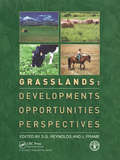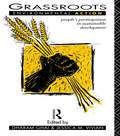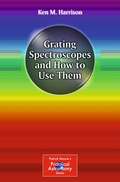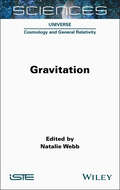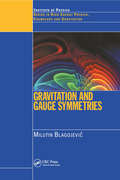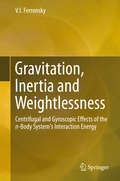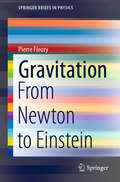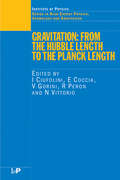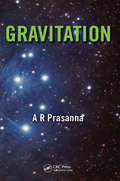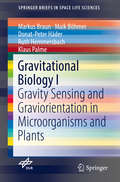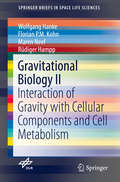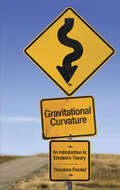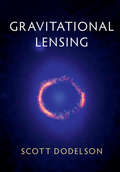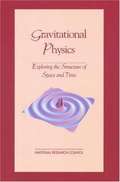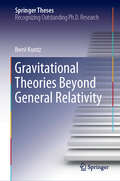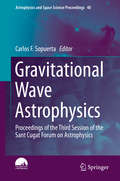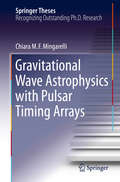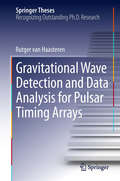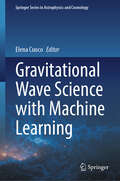- Table View
- List View
Grasslands: Developments, Opportunities, Perspectives
by S. G. Reynolds J. FrameThis book looks at significant current grassland problems and issues, and provides an insight into grassland productivity in diverse areas of the world, with their various production systems. There is a focus on recent technical advances and the prospects for further innovation, through twenty-one chapters by eminent grassland scientists, grouped i
Grassroots Environmental Action: People's Participation in Sustainable Development
by Dharam Ghai Jessica M. VivianManaging resources sustainably on the local level is essential for achieving the global goal of sustainable development. The importance of people's participation for sustainable development has recently become increasingly acknowledged yet there is little understanding of the multiple dimensions that such participation involves. Grassroots Environmental Action questions the viability of traditional management systems. Case studies from Latin America, Asia and Africa focus on areas where local people are vigorous actors in the determination of their own future and that of their environment.
Grating Spectroscopes and How to Use Them
by Ken M. HarrisonGrating Spectroscopes and How to Use Them is written for amateur astronomers who are just getting into this field of astronomy. Transmission grating spectroscopes look like simple filters and are designed to screw into place on the eyepiece of a telescope for visual use, or into the camera adapter for digicam or CCD imaging. Using the most popular commercially made filter gratings - Rainbow Optics (US) and Star Analyzer (UK) - as examples, this book provides the reader with information on how to set up and use the grating one needs to obtain stellar spectrograms. It also discusses several methods on analyzing the results. This book is written in an easy to read style, perfect for getting started on the first night using the spectroscope, and specifically showing how the simple transmission filter is used on the camera or telescope. No heavy mathematics or formulas are involved, and there are many practical hints and tips - something that is almost essential to success when starting out. This book helps readers to achieve quick results, and by following the worked examples, they can successfully carry out basic analysis of the spectra.
Grave Secrets of Dinosaurs
by Phil ManningMany of us have seen dinosaur bones and skeletons, maybe even dinosaur eggs...but what did those fearsome animals really look like in the flesh? Soft-tissue fossils give tantalizing clues about the appearance and physiology of the ancient animals. In this exciting book, paleontologist Phillip Manning presents the most astonishing dinosaur fossil excavations of the past 100 years--including the recent discovery of a remarkably intact dinosaur mummy in the Badlands of North Dakota.Bone structure is just the beginning of our knowledge today, thanks to amazing digs like these. Drawing on new breakthroughs and cutting-edge techniques of analysis, Dr. Manning takes us on a thrilling, globe-spanning tour of dinosaur mummy finds--from the first such excavation in 1908 to a baby dinosaur unearthed in 1980, from a dino with a heart in South Dakota to titanosaur embryos in Argentina. And he discusses his own groundbreaking analysis of "Dakota," discovered by Tyler Lyson.Using state-of-the-art technology to scan and analyse this remarkable discovery, National Geographic and Dr. Manning create an incredibly lifelike portrait of Dakota. The knowledge to be gained from this exceedingly rare find, and those that came before it, will intrigue dinosaur-loving readers of all ages.
Grave Secrets of Dinosaurs: Soft Tissues and Hard Science
by Phil ManningMany of us have seen dinosaur bones and skeletons, maybe even dinosaur eggs, but what did those fearsome animals really look like in the flesh? Soft-tissue fossils give tantalizing clues about the appearance and physiology of the ancient animals. Bone structure is just the beginning of our knowledge today, thanks to amazing digs like these. Drawing on new breakthroughs and cutting-edge techniques of analysis, Dr. Manning takes us on a thrilling, globe-spanning tour of dinosaur mummy finds from the first such excavation in 1908 to a baby dinosaur unearthed in 1980, from a dino with a heart in South Dakota to titanosaur embryos in Argentina. And he discusses his own groundbreaking analysis of Dakota, discovered by Tyler Lyson. Using state-of-the-art technology to scan and analyse this remarkable discovery, National Geographic and Dr. Manning create an incredibly lifelike portrait of Dakota. The knowledge to be gained from this exceedingly rare find, and those that came before it, will intrigue dinosaur-loving readers of all ages.
Gravitation (ISTE Invoiced)
by Natalie WebbThis book discusses in great detail the best theory of gravitation known to date: Albert Einstein's theory of general relativity. Based on this theory, Gravitation examines compact objects (including white dwarfs, neutron stars and black holes) and gravitational waves, and then explores the importance of relativity in cosmology, the Big Bang and the organization of structure in the universe. Many practical examples are also provided throughout the book.
Gravitation Foundations and Frontiers
by T. PadmanabhanCovering all aspects of gravitation in a contemporary style, this advanced textbook is ideal for graduate students and researchers in all areas of theoretical physics. The 'Foundation' section develops the formalism in six chapters, and uses it in the next four chapters to discuss four key applications - spherical spacetimes, black holes, gravitational waves and cosmology. The six chapters in the 'Frontier' section describe cosmological perturbation theory, quantum fields in curved spacetime, and the Hamiltonian structure of general relativity, among several other advanced topics, some of which are covered in-depth for the first time in a textbook. The modular structure of the book allows different sections to be combined to suit a variety of courses. Over 200 exercises are included to test and develop the reader's understanding. There are also over 30 projects, which help readers make the transition from the book to their own original research.
Gravitation and Gauge Symmetries (Series In High Energy Physics, Cosmology And Gravitation Ser.)
by M BlagojevicIn the course of the development of electromagnetic, weak and strong interactions, the concept of (internal) gauge invariance grew up and established itself as an unavoidable dynamical principle in particle physics. It is less known that the principle of equivalence, and the basic dynamical properties of the gravitational interaction can also be ex
Gravitation and Spacetime
by Remo Ruffini Hans C. OhanianThe third edition of this classic textbook is a quantitative introduction for advanced undergraduates and graduate students. It gently guides students from Newton's gravitational theory to special relativity, and then to the relativistic theory of gravitation. General relativity is approached from several perspectives: as a theory constructed by analogy with Maxwell's electrodynamics, as a relativistic generalization of Newton's theory, and as a theory of curved spacetime. The authors provide a concise overview of the important concepts and formulas, coupled with the experimental results underpinning the latest research in the field. Numerous exercises in Newtonian gravitational theory and Maxwell's equations help students master essential concepts for advanced work in general relativity, while detailed spacetime diagrams encourage them to think in terms of four-dimensional geometry. Featuring comprehensive reviews of recent experimental and observational data, the text concludes with chapters on cosmology and the physics of the Big Bang and inflation.
Gravitation, Inertia and Weightlessness
by V. I. FerronskyThis work discusses the problem of physical meaning of the three main dynamical properties of matter motion, namely gravitation, inertia and weightlessness. It considers that Newtonian gravitation and Galileo's inertia are the centrifugal effects of interaction energy of a self-gravitating n-body system and its potential field. A self-gravitating celestial body appears to be an excellent natural centrifuge that is rotated by the energy of interacting elementary particles. Weightlessness is a consequence of the centrifugal effect of elementary particles interaction that appears at differentiation of a body matter with respect to density. The author analyzes the problem of creation of mass particles and elements from the elementary particles of "dark matter", and discusses the basic physics of the Jacobi dynamics from the viewpoint of quantum gravitation. Chapters assert that the fundamentals of Jacobi dynamics completely correspond to conditions of natural centrifuges. The centrifuge is an excellent experimental model for the study of dynamical effects in solving the many body problem. In this book, readers may follow the demonstration of some of those studies and follow derivations, solutions and conclusions that provide a solid basis for further research in celestial mechanics, geophysics, astrophysics, geo- and planetary sciences.
Gravitation: From Newton to Einstein (SpringerBriefs in Physics)
by Pierre FleuryThis primer proposes a journey from Newton's dynamics to Einstein's relativity. It constitutes a pedagogical, rigorous, and self-contained introduction to the concepts and mathematical formulation of gravitational physics.In particular, much attention is devoted to exploring and applying the basic tools of differential geometry, that is the language of general relativity. Real-world manifestations of relativity, such as time dilation, gravitational waves, and black holes, are also discussed in detail.This book is designed for third-year bachelor or first-year master students in theoretical physics, who are already familiar with Newton's physics, possibly had an introductory course on special relativity, and who are seeking to learn general relativity on a firm basis.
Gravitation: From the Hubble Length to the Planck Length (Series in High Energy Physics, Cosmology and Gravitation)
by Ugo Moschella Vittorio Gorini Ignazio Ciufolini Pietro FréAlthough gravity is the dominant force of nature at large distances (from intermediate scales to the Hubble length), it is the weakest of forces in particle physics, though it is believed to become important again at very short scales (the Planck length). The conditions created in particle accelerators are similar to those at the time of the early
Gravitation: Proceedings Of The 15th Iagrg Conference, N. Bengal University, Nov. 4-7, 1989
by A R PrasannaThis book suitable for post graduates in Physics and Astrophysics aims at introducing the theory of general relativity as an important background for doing astrophysics. Starting from a detailed discussion of the various mathematical concepts for doing general relativity, the book introduces the geometric description of gravity. It gives a brief historical perspective to classical mechanics and electrodynamics making an attempt to establish the necessity of special relativity as propounded by Einstein extending to General Relativity. This book is a good starting point for post graduates wanting to pursue the modern topics of Cosmology, High energy astrophysics and related areas.
Gravitational Biology I: Gravity Sensing and Graviorientation in Microorganisms and Plants (SpringerBriefs in Space Life Sciences)
by Markus Braun Maik Böhmer Donat-Peter Häder Ruth Hemmersbach Klaus PalmeThis book summarizes what is currently known about gravity sensing and response mechanisms in microorganisms, fungi, lower and higher plants; starting from the historical eye-opening experiments from the 19th century up to today’s extremely rapid advancing cellular, molecular and biotechnological research. All forms of life are constantly exposed to gravity and it can be assumed that almost all organisms have developed sensors and respond in one way or the other to the unidirectional acceleration force,this books shows us some of these different ways.The book is written for plant biologists and microbiologists as well as scientists interested in space and gravitational biology.
Gravitational Biology II (Springer Briefs in Space Life Sciences )
by Wolfgang Hanke Florian P. M. Kohn Maren Neef Rüdiger HamppThis volume of the series Space Life Sciences provides insights into the latest findings of gravity research and the effect of gravity on biological systems, specifically on a cellular and molecular level. It starts by explaining the underlying physics of gravity and presenting some novel ideas on the basic principles of gravity perception. It then goes on to discuss how, in response to gravity perception, secondary messengers such as calcium and hydrogen peroxide, might control responses further downstream, like gene and protein expression and modulation. Further, it describes the consequences for animal and plant cells as well as for metabolism. Written by experts in the field, this book is a valuable resource for students and researchers in biochemistry, medicine and biomedicine, wanting to gain a solid understanding of membrane biology, secondary messenger function and gene and protein expression, specifically in the context of gravity.
Gravitational Curvature: An Introduction to Einstein's Theory (Dover Books on Physics)
by Prof. Theodore FrankelThis classic text and reference monograph applies modern differential geometry to general relativity. A brief mathematical introduction to gravitational curvature, it emphasizes the subject's geometric essence and stresses the global aspects of cosmology. Suitable for independent study as well as for courses in differential geometry, relativity, and cosmology. 1979 edition.
Gravitational Few-Body Dynamics: A Numerical Approach
by Seppo MikkolaUsing numerical integration, it is possible to predict the individual motions of a group of a few celestial objects interacting with each other gravitationally. In this introduction to the few-body problem, a key figure in developing more efficient methods over the past few decades summarizes and explains them, covering both basic analytical formulations and numerical methods. The mathematics required for celestial mechanics and stellar dynamics is explained, starting with two-body motion and progressing through classical methods for planetary system dynamics. This first part of the book can be used as a short course on celestial mechanics. The second part develops the contemporary methods for which the author is renowned - symplectic integration and various methods of regularization. This volume explains the methodology of the subject for graduate students and researchers in celestial mechanics and astronomical dynamics with an interest in few-body dynamics and the regularization of the equations of motion.
Gravitational Lensing
by Scott DodelsonGravitational lensing is a consequence of general relativity, where the gravitational force due to a massive object bends the paths of light originating from distant objects lying behind it. Using very little general relativity and no higher level mathematics, this text presents the basics of gravitational lensing, focusing on the equations needed to understand the phenomena. It then applies them to a diverse set of topics, including multiply imaged objects, time delays, extrasolar planets, microlensing, cluster masses, galaxy shape measurements, cosmic shear, and lensing of the cosmic microwave background. This approach allows undergraduate students and others to get quickly up to speed on the basics and the important issues. The text will be especially relevant as large surveys such as LSST and Euclid begin to dominate the astronomical landscape. Designed for a one semester course, it is accessible to anyone with two years of undergraduate physics background.
Gravitational Physics: Exploring the Structure of Space and Time
by Committee on Gravitational PhysicsGravitational Physics assesses the achievements of the field over the past decade in both theory and experiment, identifies the most promising opportunities for research in the next decade, and describes the resources necessary to realize those opportunities. A major theme running through the opportunities is the exploration of strong gravitational fields, such as those associated with black holes.The book, part of the ongoing decadal survey Physics in a New Era, examines topics such as gravitational waves and their detection, classical and quantum theory of strong gravitational fields, precision measurements, and astronomical observations relevant to the predictions of Einstein's theory of general relativity.
Gravitational Theories Beyond General Relativity (Springer Theses)
by Iberê KuntzDespite the success of general relativity in explaining classical gravitational phenomena, several problems at the interface between gravitation and high energy physics still remain open. The purpose of this thesis is to explore quantum gravity and its phenomenological consequences for dark matter, gravitational waves and inflation. A new formalism to classify gravitational theories based on their degrees of freedom is introduced and, in light of this classification, it is argued that dark matter is no different from modified gravity. Gravitational waves are shown to be damped due to quantum degrees of freedom. The consequences for gravitational wave events are also discussed. The non-minimal coupling of the Higgs boson to gravity is studied in connection with Starobinsky inflation and its implications for the vacuum instability problem is analyzed.
Gravitational Wave Astrophysics
by Carlos F. SopuertaThis book offers review chapters written by invited speakers of the 3rd Session of the Sant Cugat Forum on Astrophysics - Gravitational Waves Astrophysics. All chapters have been peer reviewed. The book goes beyond normal conference proceedings in that it provides a wide panorama of the astrophysics of gravitational waves and serves as a reference work for researchers in the field.
Gravitational Wave Astrophysics with Pulsar Timing Arrays
by Chiara M. F. MingarelliThis Ph. D. thesis from the University of Birmingham UK opens new research avenues in the use of Pulsar Timing Arrays (PTAs) to study populations of super-massive black hole binaries through gravitational-wave observations. Chiara Mingarelli's work has shown for the first time that PTAs can yield information about the non-linear dynamics of the gravitational field. This is possible because PTAs capture, at the same time, radiation from the same source emitted at stages of its binary evolution that are separated by thousands of years. Dr. Mingarelli, who is the recipient of a Marie Curie International Outgoing Fellowship, has also been amongst the pioneers of the technique that will allow us to probe the level of anisotropy of the diffuse gravitational-wave background radiation from the whole population of super-massive black hole binaries in the Universe. Indeed, future observations will provide us with hints about the distribution of galaxies harboring massive black holes and insights into end products of hierarchical mergers of galaxies.
Gravitational Wave Detection and Data Analysis for Pulsar Timing Arrays
by Rutger HaasterenPulsar timing is a promising method for detecting gravitational waves in the nano-Hertz band. In his prize winning Ph. D. thesis Rutger van Haasteren deals with how one takes thousands of seemingly random timing residuals which are measured by pulsar observers, and extracts information about the presence and character of the gravitational waves in the nano-Hertz band that are washing over our Galaxy. The author presents a sophisticated mathematical algorithm that deals with this issue. His algorithm is probably the most well-developed of those that are currently in use in the Pulsar Timing Array community. In chapter 3, the gravitational-wave memory effect is described. This is one of the first descriptions of this interesting effect in relation with pulsar timing, which may become observable in future Pulsar Timing Array projects. The last part of the work is dedicated to an effort to combine the European pulsar timing data sets in order to search for gravitational waves. This study has placed the most stringent limit to date on the intensity of gravitational waves that are produced by pairs of supermassive black holes dancing around each other in distant galaxies, as well as those that may be produced by vibrating cosmic strings. Rutger van Haasteren has won the 2011 GWIC Thesis Prize of the Gravitational Wave International Community for his innovative work in various directions of the search for gravitational waves by pulsar timing. The work is presented in this Ph. D. thesis.
Gravitational Wave Science with Machine Learning (Springer Series in Astrophysics and Cosmology)
by Elena CuocoThis book highlights the state of the art of machine learning applied to the science of gravitational waves. The main topics of the book range from the search for astrophysical gravitational wave signals to noise suppression techniques and control systems using machine learning-based algorithms. During the four years of work in the COST Action CA17137-A network for Gravitational Waves, Geophysics and Machine Learning (G2net), the collaboration produced several original publications as well as tutorials and lectures in the training schools we organized. The book encapsulates the immense amount of finding and achievements. It is a timely reference for young researchers approaching the analysis of data from gravitational wave experiments, with alternative approaches based on the use of artificial intelligence techniques.
Gravitational Waves
by Ugo Moschella Vittorio Gorini Ignazio Ciufolini Pietro FréGravitational waves (GWs) are a hot topic and promise to play a central role in astrophysics, cosmology, and theoretical physics. Technological developments have led us to the brink of their direct observation, which could become a reality in the coming years. The direct observation of GWs will open an entirely new field: GW astronomy. This is expe
